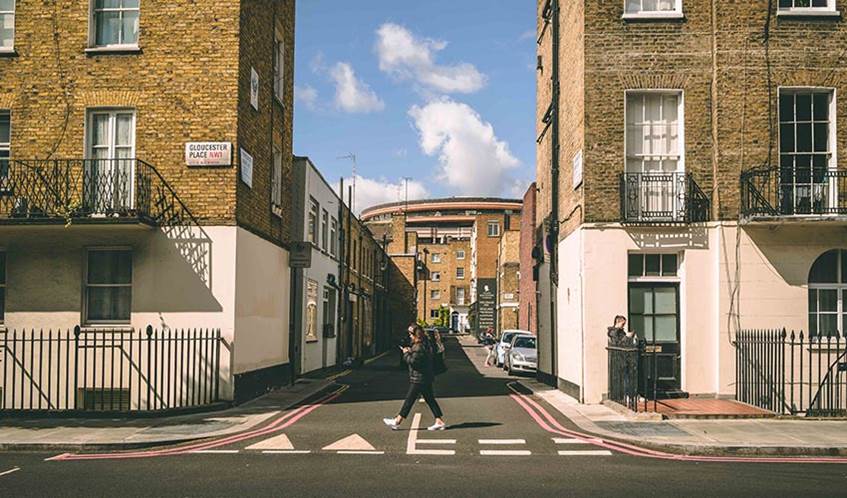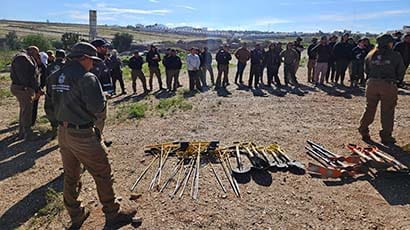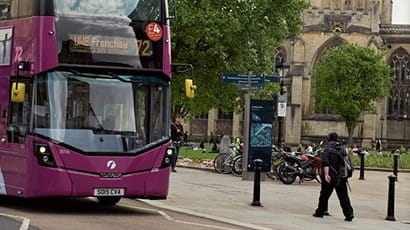Enhanced junction designs “make it clear to drivers that they need to give way”

A recently completed research project has identified two side road crossing designs that encourage drivers to give way to people crossing and waiting to cross – as required by the Highway Code since January 2022.
The project was carried out by academics at the University of the West of England (UWE Bristol), with funding provided by The Road Safety Trust.
The researchers set out to understand the impacts of enhanced side road designs that both increase priority and reduce risk for people walking and cycling. It is particularly significant because of changes to the Highway Code that came into effect from 29 January 2022.
These changes mean drivers turning in or out of a side road should now give way not only to pedestrians and cyclists who are crossing, but also to waiting pedestrians and approaching cyclists.
The research team from UWE Bristol’s Centre for Transport and Society, observed behaviour at different types of side road crossing and revealed two designs where drivers were more likely to give way:
- Marked Priority crossings with so-called ‘parallel crossings’ that have a zebra for pedestrians and priority markings for the cycle track crossing.
- Design Priority crossings, also called continuous footways, where priority is reinforced by the layout and surface materials.
With both of these enhancements, people crossing did not have to yield to drivers in approximately 90% of interactions compared with 43% of interactions at conventional junctions.
The researchers found that users realise the importance of Marked Priority and Design Priority enhancements being implemented consistently and appropriately across the country in order to minimise ambiguity and confusion.
The project was led by John Parkin, professor of transport engineering and deputy director of the Centre for Transport and Society at UWE Bristol.
Professor Parkin said: “Many side road junctions are designed mainly with movement for vehicles on the carriageway in mind, and they have generous corner radii and wide carriageways. The key point is that priority for people crossing, as required by the Highway Code, is not clear from the design.
“The project explored the use of priority markings that make it clear to drivers that they need to give way to pedestrians and cyclists who are crossing a side road. These are give way markings placed before the pedestrian and/or cycle track crossing, and sometimes also a zebra crossing for pedestrians.
“The findings have been compared with previous research on priority that has been enhanced by the design having a raised footway and/or cycle track that is continuous across the side road.
“On nearly half of occasions at conventional junctions, people crossing yielded voluntarily to turning drivers. The effect of enhanced junctions was to reduce this proportion and created more occasions when drivers gave way to people crossing. Both Marked Priority designs with a zebra, and Design Priority designs (continuous footways) increased the proportion of times people did not yield to vehicles from around 50% at control sites to around 90%.”
Sonya Hurt, chief executive of The Road Safety Trust, said: “When it comes to encouraging more people to walk and cycle, safety is paramount.
“We are delighted with the outcomes from this project, including recommendations for side road crossing designs most likely to encourage drivers to give way, thereby reducing risk for those travelling by foot or on bike.”
To find out more about the project, visit The Road Safety Trust website.
Related news

18 December 2025
UWE Bristol professor appointed National Institute for Health and Care Excellence CEO
Jonathan Benger CBE, Professor of Emergency Care at UWE Bristol, has been appointed as the new chief executive officer of the National Institute for Health and Care Excellence (NICE).

17 December 2025
Findings revealed from first UK study into experiences of mothers who are survivors of rape pregnancy
UWE Bristol academics have revealed the findings of the first UK-based study of the experiences of mothers who are survivors of rape pregnancy.

11 December 2025
Social media influencer work is far more demanding than it looks, research finds
A study exploring the mental health impacts of social media influencer work has revealed that life online is far more demanding than it appears.

25 November 2025
UWE Bristol experts join film Q&A exploring music and melodrama
Academics will take part in the Cary Comes Home Festival, with a post-screening Q&A exploring music, melodrama and emotional storytelling in classic cinema.

17 November 2025
Urgent reform needed to support ambulance-delivered end of life care, study finds
More than three quarters (78 per cent) of paramedics sometimes fear doing the wrong thing when caring for people in the last year of life, new research has found.

13 November 2025
Bristol’s screen industry experiences “boom-and-bust cycle” after post-pandemic recovery, new research from UWE Bristol finds
New research from UWE Bristol provides detailed insight into Bristol's screen sector.

13 November 2025
New AI research to revolutionise animal welfare
A UWE Bristol research project will combine behavioural science and AI to create technology that understands not only what animals do, but how they feel.

10 November 2025
Lessons from Low Traffic Neighbourhoods will drive better public engagement, study finds
Lessons from Low Traffic Neighbourhoods have informed a new toolkit to improve engagement with the public on challenging local street issues.

06 November 2025
First-of-its-kind study aims to help more people spend their final days at home
A new study will explore how architectural design could support end-of-life care in domestic settings.

29 October 2025
UWE Bristol academic unveils breakthrough in energy-efficient AI at NATO science forum
Dr Jonathan Lancelot has developed a new form of AI that could transform how intelligent machines operate in space, defence, and remote environments.

15 October 2025
UK food needs radical transformation on scale not seen since Second World War, new report finds
A new report from the Agri-Food for Net Zero Network+ finds urgent action on food is needed if the UK is to reboot its flagging economy, save the NHS billions, ensure national food security, and meet climate commitments.

07 October 2025
Academic playing role in project to find hidden graves in Mexico using drone technology
A UWE Bristol lecturer is playing a part in a project using drone technology to locate concealed graves in Mexico.
You may also be interested in

Find an expert
Media contacts are invited to check out the vast range of subjects where UWE Bristol can offer up expert commentary.

Media enquiries
Enquiries related to news releases and press and contacts for the media team.

Centre for Transport and Society (CTS)
More information about the Centre for Transport and Society, including research projects, transport courses, news, events and opportunities.






